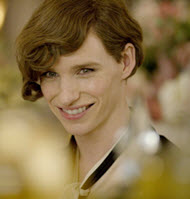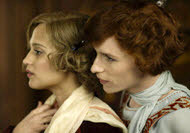The Danish Girl
 for some sexuality and full nudity.
for some sexuality and full nudity.
Reviewed by: Jim O'Neill
CONTRIBUTOR
| Moral Rating: | Very Offensive |
| Moviemaking Quality: |
|
| Primary Audience: | Adults |
| Genre: | Pseudo-Biography Drama Adaptation |
| Length: | 2 hr. |
| Year of Release: | 2015 |
| USA Release: |
October 8, 2015 (festival) November 27, 2015 (limited) December 25, 2015 (wide) DVD: March 1, 2016 |





man dressing as a woman
“transgender” male-to-female homosexual / “gender reassignment” surgery

No, it’s based on the FICTION novel The Danish Girl by gay writer David Ebershoff, which is a “fictionalized account of the life of Einar Wegener/Lili Elbe, not an actual biography. The author changed so many elements of Einar Wegener’s story that the characters in the book are entirely fictional, no other character in the novel has any relation to an actual person, living or dead.
Historical accounts claim that Gerda Wegener was a lesbian and that she preferred Lili’s femininity over Einar’s masculinity and that they had an open relationship. The love story portrayed in the novel and in the film is fiction, Gerda and Lili did not remain close after their marriage was annulled.” [Source: IMDbPro.com]

GAY—What’s wrong with being gay? Answer
Homosexual behavior versus the Bible: Are people born gay? Does homosexuality harm anyone? Is it anyone’s business? Are homosexual and heterosexual relationships equally valid?
What about gays needs to change? Answer
It may not be what you think.
What does the Bible say about same sex marriages? Answer
Can a gay or lesbian person go to heaven? Answer
If a homosexual accepts Jesus into his heart, but does not want to change his lifestyle, can he/she still go to Heaven?
What should be the attitude of the church toward homosexuals and homosexuality? Answer
Read stories about those who have struggled with homosexuality
jealousy
adultery / extramarital affair / infidelity
sin and the fall of man
compare goodness and righteousness



| Featuring |
|---|
|
Eddie Redmayne … Einar Wegener / Lili Elbe Alicia Vikander … Gerda Wegener Amber Heard … Ulla Ben Whishaw … Henrik Matthias Schoenaerts … Hans Axgil See all » |
| Director |
| Tom Hooper — “Les Misérables” (2012), “The King's Speech” (2010), “John Adams” (TV Mini-series—2008) |
| Producer |
|
Artémis Productions Pretty Pictures ReVision Pictures Working Title Films |
| Distributor |
Tom Hooper’s “The Danish Girl” strives for the intimacy and mystery of a lady’s boudoir, a delicate but proprietary place evoked lovingly by Titian, Degas and Ingres. Although Hooper’s film is no “Venus with a Mirror” or “After the Bath,” there are moments when it delights in a way that those paintings do. It is as soft as satin, as sheer as tulle, and as sweet as marzipan. Like marzipan, though, the first taste may be dizzyingly sweet, but the second, third and fourth bites can be cloying and wince-inducing. There is only so much finery the senses can take before the taste buds, and the eyes, shout: Enough!
The film, adapted by Lucinda Coxon from the 2002 novel by David Ebershoff, takes place in 1920s Denmark. It tells the story of Einar Wegener (Eddie Redmayne), a successful landscape painter who attempts to transform himself into a woman who would henceforth be called Lili Elbe. Einar lives with his wife, Gerda Wegener (Alicia Vikander), a struggling portraitist. Their marriage appears to thrive in a world of art studios, society cafes and gallery parties, but their fortunes take a turn when Gerda is pressed to finish a ballerina portrait before its rapidly approaching deadline. Her model fails to show up for the last session, so she asks her husband to don the ballet costume and pose for her. He obliges.
If only Gerda had let that deadline pass…
When Einar puts on the stockings, and holds the dress up to his chest, a transformation takes place. He sees something in himself that he had not seen before, something that lay hidden beneath the tutu’s multi-layered ruffles, and his own male body. That something, a kind of embryo waiting to be born, bursts forth with no time allotted for having a second thought or taking a deep breath. Einar, the caterpillar, is now Lili, the would-be butterfly. But try as he might, and Einar does try, he cannot escape what he sees as the larval stage of his development. He remains a kind of Alice in Wonderland caterpillar who has the fancy wardrobe, but also has too much baggage to ever take flight. When Einar dresses as Lili, he appears more lost soul than new self. He looks no more feminine than Milton Berle or Eric Idle when they dressed in drag to get a laugh.
The flesh may be willing, but the spirit just isn’t there.
The principles and motivations that bring all this on are never made clear. We are given no clues from Einar’s childhood other than a kiss that may or may not have meant something. We get no insight into what influence parents, siblings or peers may have had on his development. This “based on fact” account of Einar’s transition to Lili is as pretty as lip-gloss and just as deep. It’s as if the filmmakers intended to pat us over and over with a powder puff but leave us without the foundation make-up.
Lili makes the decision to undergo transgender surgery, the details of which are mercifully left out of the film. The descriptions of the multi-stage procedure can be found in other accounts of Lili’s life and in Ebershoff’s novel. The surgical techniques used on Lili are notable for their lack of scientific integrity, their disregard for the dignity of the human person, and their rejection of common sense. It is, therefore, no surprise that Lili’s series of operations were not only unsuccessful, but ultimately destructive.
Eddie Redmayne is an understandable choice to play Einar, and he gives a performance that clicks here and there, but ultimately falls short. He has a captivating smile, and he evokes a coyness that Vivien Leigh would envy. He lets his slender body droop, his shoulders slouch and his legs twist in an S-shaped curve that would earn him an A+ grade from Miss Manners. He gets all the poses right. Perhaps that is why the portraits Gerda paints of Einar as Lily have such flair. You can see why they sell. But in real life, Einar as Lili does not close the sale. And neither does Redmayne.
The actors who surround Redmayne do most of the heavy lifting. Ben Whishaw plays a would-be lover and Matthias Schoenaerts plays a childhood friend who tries in vain to help the struggling Einar and Gerda. Both make the most of underwritten and poorly defined parts.
The heart of the movie is Alicia Vikander who plays Gerda, Einar’s wife. Gerda is compassionate and supportive, but she is also full of doubt and guilt. Vikander reveals every aspect of a woman thrown into an impossible situation: grit, fear, woe, and occasional joy. All the things that go with love. Vikander’s performance holds the movie together; she is fascinating to watch, even when the movie turns insipid and vapid.
“The Danish Girl” gives some historical perspective to a contemporary dilemma. Doing so should bring some light on where we have come and how we got there. The film has its charms, but it shies away from examining the psychological complexities and the moral truths that could have made it a worthy costume drama, instead of an empty pantsuit.
After watching this film my fellow viewers and I asked each other a series of questions:
Does God have a plan for each of us?
Is our gender part of that plan?
Is our gender a gift from Him?
Is that gift precious enough to keep and be thankful for, or is it something we can exchange?
If we exchange it, what are we saying about the giver, and about ourselves?
Violence: Moderate / Profanity: Moderate—“My G*d”/ Sex/Nudity: Heavy to Extreme—bare breasts and buttocks, full male nudity, sex play, paintings with full nudity, frank sexual talk, genitals in pictures, etc.
See list of Relevant Issues—questions-and-answers.


As Christians we tend to intellectualize morally clear matters more often than is healthy. An intelligent analysis of the facts are far more enlightening: The fact that someone of one sex is interested in what it might be like to be someone of the opposite sex does not make them that sex. What it makes them is nothing more than curious, like all human beings. It becomes more than curiosity when they disguise sex as something less than what it truly is. Rather than being composed of attitudes and behaviors, a person’s sex is determined by what the entire span of their lives in God’s plan for eternity is. See all »
Moral rating: / Moviemaking quality:
Through out the Bible, there are distinctions between the genders and the LORD’s calling for us. Recent changes in society that have been accepted by the church has added to the confusion.
Deuteronomy 22:5 — “A woman shall not wear man’s clothing, nor shall a man put on a woman’s clothing; for whoever does these things is an abomination to the LORD your God.
Ephesians 5:22-33 shows the symbolic truth of what we represent to the world showing the relationship of the LORD to His people, as in the relationship of a husband and wife. Of men and women. A study of Scripture will banish any thoughts of the rationalization the world has presented. May we look at such things through the lens of Scriptural, not the false way of the world. It is not loving to encourage others in ways that are not of the LORD!
PLEASE share your observations and insights to be posted here.


My Ratings: Moral rating: Offensive / Moviemaking quality: 5